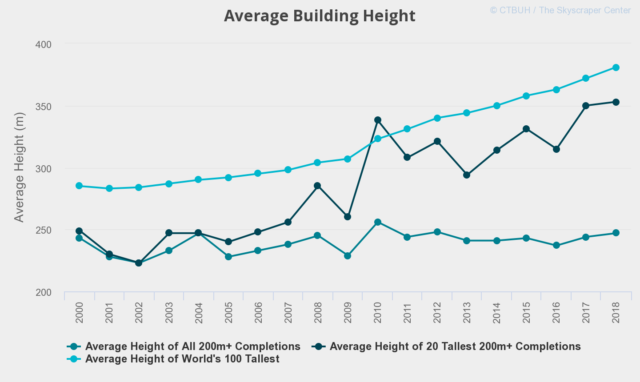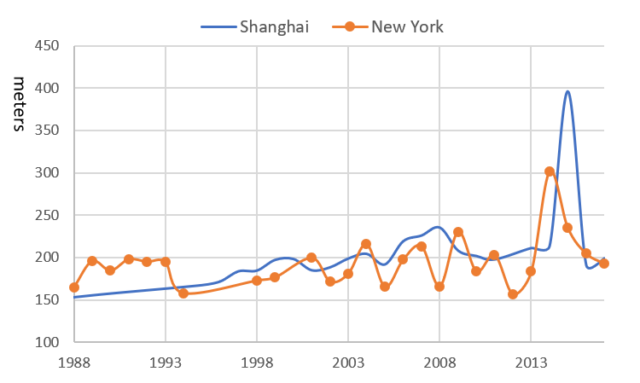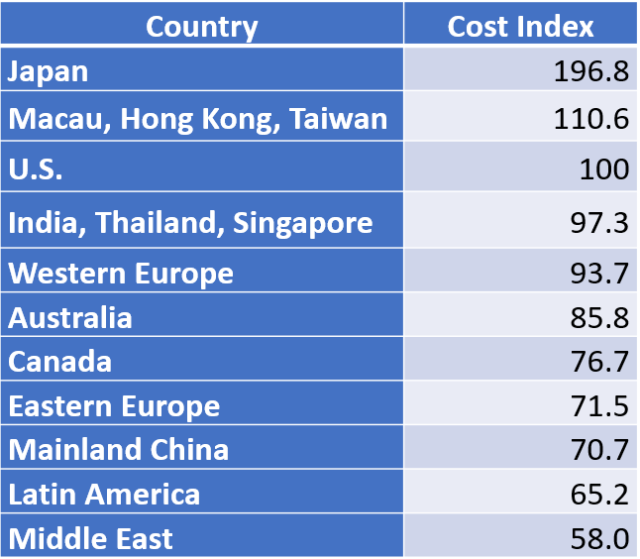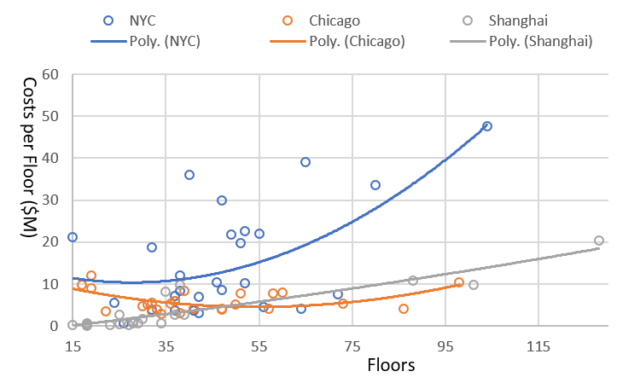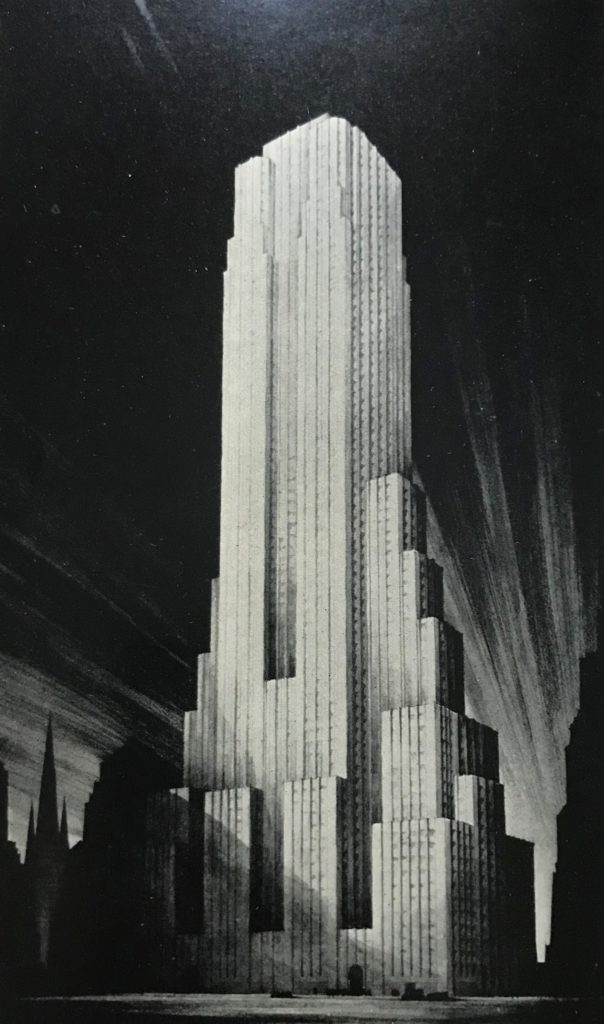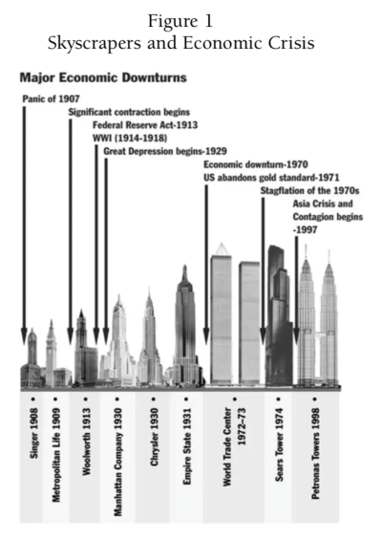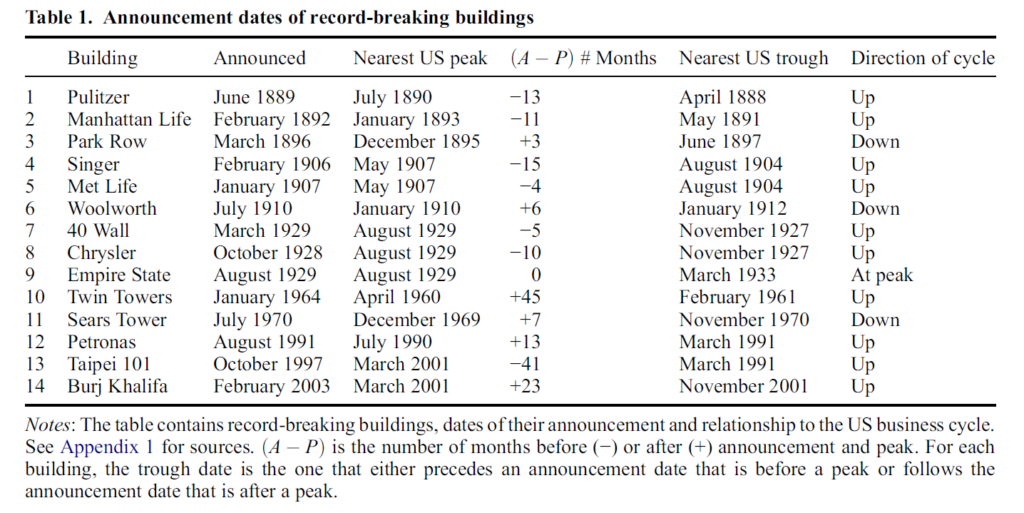Jason M. Barr September 24, 2019
Note this is Part II of an on-going series on the evolution of skyscraper technology. The rest of the series can be found here.
The Chicken or the Egg?
What came first: building height or elevator speed? The history of skyscrapers brings us to a kind of chicken-and-egg conundrum. Does the drive to build tall come first and then fast elevators come next? Or do rapid elevators show what’s possible and then developers exploit them to go taller? While I don’t think there’s any way to answer this question, we can look at the history of the elevator to get a sense how this co-dependency has evolved.
We can say for sure that there is a symbiotic relationship between building height and elevator speed, and together they have enabled cities to grow upwards and hold more people and businesses. Ironically, elevator speed history emerges out of a strange paradox. People are willing to spend an hour or more commuting each day—idling in traffic or dawdling on trains—but when they get to a building, they expect to get from the ground floor to their destination in less than two minutes. It’s the quest for convenience, as much as speed, that has driven the technology forward.
The Birth of Vertical Transportation
Modern elevators are products of the Industrial Revolution, and were first installed in factories, mines, and warehouses. By the 1830s, for example, they were in numerous British textile mills. By the 1840s they were used for passengers. Bunker Hill Monument in Boston, erected in 1842, had a steam-powered lift to take visitors to an observation deck. Wealthy people started putting them into their homes in the 1850s. The first commercial elevators seems to have been installed in New York City before the Civil War. The two earliest examples are the 5-story Haughwout Building (1857) in Soho, and the Fifth Avenue Hotel (1859) at Madison Square Park. Over the ensuing decades, inventors and entrepreneurs continued to advance the art and science of elevatoring to make them faster and safer.
The Safety Break?
The conventional story regarding the elevator revolution begins in 1854. In that year, in New York’s Bryant Park, the Exhibition of the Industry of All Nations—housed in a specially-constructed “Crystal Palace”–demonstrated the world’s cutting edge technology. One vendor present was Elisha Otis. He was showcasing his elevator prototype. In front of large crowds, he climbed onto the platform and hoisted it up a story or so. And then–dramatically–cut the rope holding it in place—producing terror that it would crash. And yet, it did not. The elevator hardly moved. His new safety break kicked in and rescued him from injury and obscurity. Since that dramatic display, the story goes, the elevator’s success shot upwards, now that fear of free-falling was gone. This story has been repeated ad infinitum as the pivotal moment for elevators and skyscrapers.
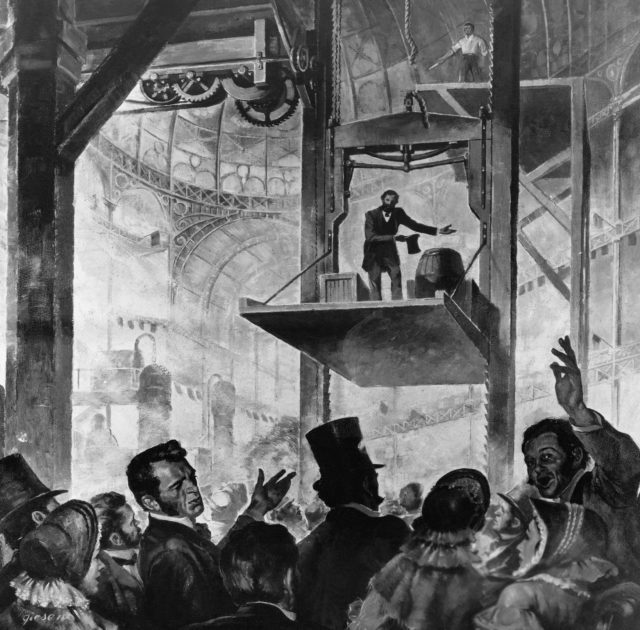
Myth Busting
Yet according to Andreas Bernard, author of the 2014 book, Lifted: A Cultural History of the Elevator, the story is not so simple. His search for contemporaneous reporting on this “viral” moment came up short. In fact, he finds, at the time, nary a mention in the press. He argues that for such a seemingly pivotal moment in history, hardly anyone seemed to care. He writes,
In the major American daily newspapers and magazines, the 1854 event showed up only in two marginal locations. In addition to the Scientific American article, a brief report appeared on May 30, 1854, in the New York Daily Tribune, which mentioned the daring of the inventor “who, as he rides up and down the platform occasionally cuts the rope by which it is supported.” No further contemporary traces can be found (just as there were no obituaries of Elisha Otis in 1861). Thus it is no exaggeration to say that the demonstration in the Crystal Palace, that “authentic great moment in architectural history,” went almost completely unnoticed by the public.
The story, evidently, is another case of history being written by the winner. Thanks to the diligence of Otis and his offspring, his company went onto to be one of the largest manufacturers of elevators in the world. In 1911, Elisha’s son Charles set out to “correct the record” about elevator history by writing his version of the events, and which minutely chronicled the display in the Crystal Palace. As Bernard writes,
The influence of … [Charles Otis’] text on the historiography of the elevator is obvious from the fact that after 1911, there was hardly a mention of the elevator’s origins that did not begin by repeating the story of the event in the Crystal Palace.
The First Skyscraper?
As a side note, this story has a familiar ring in regard to the world’s first skyscraper. The conventional wisdom is that it was the Home Insurance Building in 1885, designed by William Le Baron Jenney. But this notion seems to have been the product of Chicagoans winning the battle of historiography. The Home Insurance Building, while novel, could not, by today standards be fully described as a “skyscraper” in that it was not fully iron (or steel) skeletal structure.
At the time, many architects and engineers were developing technologies and methods in parallel. In the years after the first skyscrapers emerged in Chicago and New York, there was a battle within the community to claim the prize of “First Skyscraper.” Jenney argued it was his structure; while New York’s Bradford Lee Gilbert said his Tower Building (1889) was first. Others also offered proof they were the true innovators. In the end, through good marketing, Chicago remains the winner in our minds, but this claim highly debatable and far from conclusive.
The Birth of the Rent Premium
Once vertical transport revealed itself to be practical, however, another revolutionary moment was created. Likely, for the first time in human history, was an inversion in the economic and social value of higher floors. Before that, when climbing was the only way up, the top stories were naturally hard to get to. No one wants to climb more than a few floors; as a result, the highest floors were rented to those with the lowest ability to pay. Offices used them for storage or for their low-level clerks.

In a way, the elevator created treasure in the sky. Because vertical movement was fast and cheap, it generated a rent premium for the higher floors. That is say, the amount of rent paid, per square foot or meter, was higher as one rose up. Today, that premium in New York City is between 0.5 and 1% per floor. In other words, prices on 30th floor of a skyscraper might rent for up to 20% more per square foot as compared to the same space on the 10th floor. Developers realized if they could get their building occupants up there, they could reap more profits. And the race for height was on. This rent inversion was first noticed in New York City in 1870, when The Equitable Life Assurance Society built it’s 7-story headquarters near Wall Street, and which included two elevators.
The Value of a View?
How much of this premium is due to views, or increased social status, or more productive workers is still not fully understood; but what is clear is that people in big cities are willing to pay to be high in the sky. It’s also worth noting that this benefit also rests on our particular evolutionary history. Imagine that all humans had an innate fear of heights; that working in high-rise building automatically generated dread and anxiety? If so, the world would look radically different.
Elevator Dilemmas and their Remedies
The earliest elevators were driven by steam or hydraulics. And it was not until widespread use of electricity in the 1880s that efficient speeds were obtainable. Once this barrier was removed, however, a host of new problems arose. Faster speeds allow for taller buildings, which means more people, which generates more congestion and logistical problems in getting people to their final destinations. For example, there’s the problem of waiting times once you push the button in the lobby. Then there’s limits on how many people can fit in one cab. And when it is filled with passengers, it seems to stop on a million floors before you get to yours. Not to mention the fact it’s socially awkward to stand in a cramped box with 15 strangers.
The Pain Index
Keep in mind that, in theory, one can move people faster by creating more elevator shafts and this is certainly necessary for larger or taller buildings. But extra shafts are the bane of developers, since they eat up income-generating space. For the time being, we are going to hold the number of elevators constant and focus more on movement and speed. We will come back to the “shafts problem” in a future post.
The key challenge for efficient mobility is that of minimizing what has been referred to as the Pain Index—the total time to it takes from once you hit the button to when arrive at your final location. Evidently, however, it’s not clear what people hate more—waiting in the lobby for the elevator to arrive, stopping more inside the elevator, or getting into a crowded car.
Traffic Flow and Optimal Stopping
One of the key problems is that of peak usage times. For example, in offices at 8:30am, it seems every employee wants to get into the elevators at the same time. With the old-school call system, when multiple users push the call buttons at the same time, the elevators move to where they were called first. But when many buttons are pushed at the same time the system gets gummed up, increasing waiting time.
Computing technology and software programming has helped mitigate the problem of how to efficiently allocate car space during the day and based on different kinds of traffic patterns. Today, most modern elevator systems employ computer algorithms to minimize travel times, using what is called the Destination Dispatching System (DDS). In real-time, the system analyzes the input data–where the buttons where pushed–and makes a list of who to put in which cars and where the cars are to stop. If with conventional elevators waiting took over a minute, the DDS could reduce that time to half.
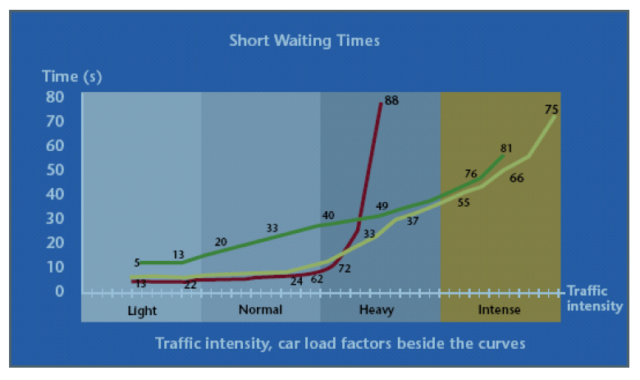
Zoning and the Double Decker
For a given set of elevator shafts, the spaces can be used more rationally by the use of zoning and double decking. Zoning is the process of limiting specific elevators to operate only in predefined zones. One elevator can stop for local service, but another one say only goes from the lobby to the higher floors. Zones are normally kept to around 10-20 floors. This reduces the number of stops for the zoned cars and speeds up its return to the lobby. To allow for even higher heights, supertall buildings often have sky lobbies where an express elevator take you there and then you transfer to a separate elevator that operates only up high. For very tall buildings, another way to use the shaft space more efficiently is to have two elevators operate within the same shaft. One way to do this is to have one elevator car sit on top of another, creating the double decker. Odd-floor travelers enter the bottom car, while even-floor travelers enter the top car after walking up a ramp.
Cable Height
As buildings get taller, the amount of rope needed to connect the elevator car to the motor becomes longer and longer. This is a problem as conventional ropes, made of steel, can cease to be functional. In very tall buildings, nearly 70% of the elevator’s weight comes from the cable itself and when it gets too long it cannot support its own weight. Companies that manufacture elevator systems are thus in a race to develop new types of ropes that are both stronger and lighter. With conventional ropes the highest that one elevator car can travel is 500 meters (1640 feet; about 140 floors). After that, going taller requires transferring to a new elevator at a sky lobby. The Jeddah Tower is going to install KONE’s “UltraRope,” which has a carbon-fiber core, making it particular light and strong. With this rope, cars can now travel up to 1000 meters (3280 feet), and it pushes possible skyscraper heights upwards (is this the egg for first mile-high tower?).
Human Physiology
Then there’s the problem of the human body, with its delicate carbon-based controllers and pain receptors. To quote James Fortune, a partner at FS2 Consulting, which specializes in elevator designs for supertall towers, “The human body has various internal sensors that are sensitive to external motion forces, noise, and vibrations. These sensors provide constant feedback to the brain and are quite responsive to any “out of the ordinary” elevator vibrations or noises.”
In particular, humans are quite sensitive to the acceleration and deceleration rates, which can cause ear discomfort due to the rapid changes in air pressure. Fortune says that, “However, ear comfort and pressure changes do not usually affect healthy elevator riders unless the descent speeds exceed 10 meters per second (m/s) and vertical travel exceeds 500 meters. For this reason, virtually all the latest supertall high-speed lifts, with “up” travel speeds to 10 to 20.5 m/s, have a maximum “down” speed of 10 m/s. Some cutting edge elevators, such as those installed at One WTC add extra air pressure on the way up to help prevent the annoying ear-popping sensation.
A History of Speed
While it’s fun to focus on the history of speeds, the truth is that the fastest elevators in the world are mostly used for visiting decks and/or to give bragging rights to the developers and companies that install them. For most office buildings, the average maximum speed is about 21 feet per second (5.8 m/s). Nonetheless, as the technology for speed and comfort progresses, it is likely that their benefits will be more widespread. In 1913, the world’s tallest skyscraper, the Woolworth Building, had a maximum speed of 11.6 feet per second (3.6 m/s). In 1931 the Empire State Building, had a maximum speed of 20 feet per second (6.1 m/s). So in in some sense, the top elevator speeds for the typical building haven’t changed all that much. What has changed is that passengers can be much more rapidly moved based on logistical algorithms, zoning, and double deckering. The efficient allocation of occupants is really what allows for buildings to go taller and taller.
The Record Breakers
Be that as it may, the figure below demonstrates the history of maximum elevator speeds over the last century. The left figure shows the speeds (feet per second) for the world’s record-breaking skyscrapers. (Note the Shanghai Tower is also added to the graphs. It did not have record-breaking height but did have record-breaking elevator speed). This figure is clear: maximum elevator speeds have been rising over time. A back-of-the-envelope calculation shows that from the Singer (1908) to the Shanghai (2015), the maximum speed as increased at an average annual rate of 1.78% per year.
The right figure is speed versus the number of stories for the world’s record-breaking buildings. Again, we see a positive relationship. But, while the graph shows elevator speed versus height, we could be equally as justified in showing height versus speed, since we still can’t say which was the chicken and which the egg. All we can say is that the graph shows a strong correlation but says little about causality. Another thing, however, pops out in this graph: the world’s fastest elevators are not in the world’s current record-breaker.
The Burj Khalifa’s elevators can move at a speed of 33 feet per second (10 m/s) and the Jeddah Tower, under construction, is expected to be the same. These are much slower than the Taipei 101 and the Shanghai Tower. In other words, what these findings suggest, again, is that speed, in and of itself, is not paramount. Likely the cost of operating super fast elevators and need to maintain passenger comfort and efficiency of movement currently trump speed.

The Future of Vertical Transportation
What’s in store for the future? Certainly, we can say that the big five manufactures–Otis, KONE, Thyssenkrupp, Schindler, and Mitsubishi–will continue to invest in R&D to push the elevator envelope, thus encouraging developers to build taller. But what revolutionary technology comes next? Who knows? Likely futuristic buildings will have mag lev elevators with horizontal circulation. In 1957, Frank Lloyd Wright’s design for the one-mile high building called for nuclear powered elevators. But we’ll leave a discussion of these moon-shot technologies for the future, or rather, a future post.
Continue reading. The rest of the series on the technology of tall can be found here.
